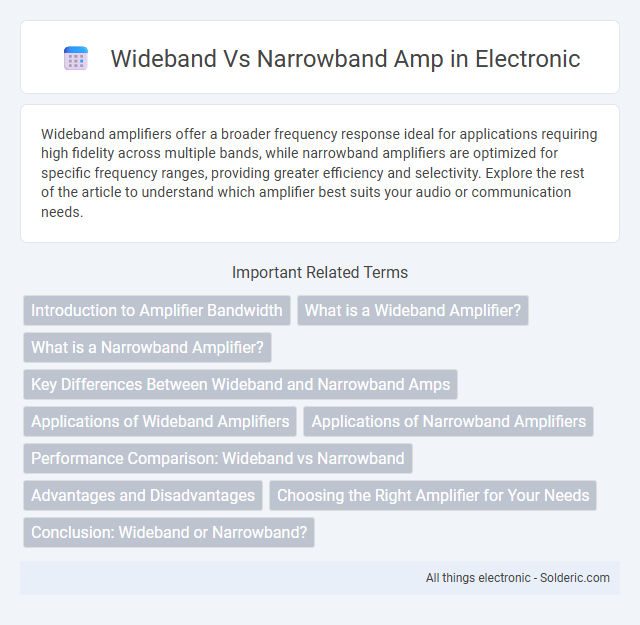Wideband amplifiers offer a broader frequency response ideal for applications requiring high fidelity across multiple bands, while narrowband amplifiers are optimized for specific frequency ranges, providing greater efficiency and selectivity. Explore the rest of the article to understand which amplifier best suits your audio or communication needs.
Comparison Table
| Feature | Wideband Amplifier | Narrowband Amplifier |
|---|---|---|
| Frequency Range | Broad spectrum, typically above 100 MHz | Narrow spectrum, specific frequency bands |
| Gain | Moderate across wide frequencies | High gain at targeted frequency |
| Applications | Multi-band communication, test equipment | Radio receivers, signal processing |
| Complexity | Higher due to wide frequency handling | Lower, optimized for single band |
| Noise Figure | Typically higher due to broad range | Lower noise in focused band |
| Power Efficiency | Generally lower | Generally higher |
Introduction to Amplifier Bandwidth
Amplifier bandwidth refers to the range of frequencies an amplifier can effectively process without significant signal loss or distortion. Wideband amplifiers support a broad spectrum of frequencies, enabling applications like high-speed data transmission and wide-frequency communication systems, while narrowband amplifiers focus on a specific, limited frequency range for tasks such as radio broadcasting or audio amplification. Understanding the bandwidth characteristics of an amplifier is crucial for optimizing performance in systems requiring precise frequency handling.
What is a Wideband Amplifier?
A wideband amplifier is designed to amplify a broad range of frequencies, typically spanning from hundreds of kilohertz to several gigahertz, making it ideal for applications requiring high-frequency signal processing with minimal distortion. Unlike narrowband amplifiers, which target a specific frequency or a narrow frequency range for maximum gain and selectivity, wideband amplifiers maintain consistent gain across a wide spectrum. This makes wideband amplifiers essential in communications systems, radar, and broadband signal analysis where preserving signal integrity across multiple channels or frequencies is critical.
What is a Narrowband Amplifier?
A Narrowband Amplifier is designed to amplify signals within a specific, limited frequency range, typically enhancing performance for applications where signal precision is critical. It offers high gain and selectivity, making it ideal for communication systems, radar, and satellite links that require minimal noise and interference outside the target frequency band. Your choice between wideband and narrowband amplifiers depends on whether you need focused amplification or broader frequency coverage for your signal processing needs.
Key Differences Between Wideband and Narrowband Amps
Wideband amplifiers cover a broad range of frequencies, allowing for consistent gain across multiple channels or applications, making them ideal for broadband wireless and multi-service networks. Narrowband amplifiers, in contrast, are optimized for a specific frequency or a narrow range, offering higher gain and better noise performance tailored to particular signals or communication standards. The choice between wideband and narrowband amps depends on the application's frequency diversity requirements and the need for signal fidelity versus amplification efficiency.
Applications of Wideband Amplifiers
Wideband amplifiers are essential in applications requiring amplification across a broad frequency spectrum, such as radar systems, wireless communications, and medical imaging. These amplifiers enable high-speed signal processing and support technologies like 5G networks and broadband satellite transmissions. Your device benefits from improved signal integrity and reduced distortion when utilizing wideband amplifiers in these advanced communication systems.
Applications of Narrowband Amplifiers
Narrowband amplifiers excel in applications requiring selective frequency amplification, such as in communication systems, radar, and signal processing where precise frequency filtering is crucial. They are preferred in scenarios like satellite communications and cellular base stations due to their high gain and low noise within a limited frequency range. This specialization enhances signal clarity and reduces interference, making narrowband amplifiers ideal for frequency-sensitive tasks.
Performance Comparison: Wideband vs Narrowband
Wideband amplifiers deliver superior performance by amplifying signals over a broader frequency range, enabling better handling of complex, high-frequency data transmissions compared to narrowband amplifiers that focus on a limited frequency spectrum. Narrowband amplifiers typically offer higher gain and lower noise figures within their confined bandwidth, optimizing signal clarity for specific applications such as voice communication or single-channel radio. The choice between wideband and narrowband amplifiers hinges on the balance between frequency coverage and signal purity, with wideband suited for versatile, multi-frequency environments and narrowband excelling in targeted, high-precision amplification.
Advantages and Disadvantages
Wideband amplifiers offer the advantage of amplifying a broad range of frequencies, making them ideal for applications requiring high fidelity and wide spectral coverage, such as wireless communication and audio systems. Narrowband amplifiers provide higher gain and improved selectivity within a limited frequency range, enhancing signal quality and reducing noise in specific channels like radio transmitters. Your choice depends on whether you prioritize frequency range versatility with moderate gain or focused amplification with superior noise performance.
Choosing the Right Amplifier for Your Needs
Wideband amplifiers provide a broad frequency response ideal for applications requiring high-fidelity audio or multi-band communication, offering consistent gain across a wide spectrum from a few kHz up to several GHz. Narrowband amplifiers focus on a specific frequency range, delivering higher gain and improved noise performance for targeted applications such as single-channel radios, radar systems, or specific sensor frequencies. Selecting the right amplifier depends on the application's frequency range, desired signal quality, and system complexity, ensuring optimal performance and efficiency.
Conclusion: Wideband or Narrowband?
Wideband amplifiers deliver a broader frequency response ideal for applications requiring high-fidelity signal amplification across multiple channels, while narrowband amplifiers excel in boosting signals within a specific frequency range with minimal noise. Your choice depends on whether you prioritize versatility and signal clarity across various frequencies or enhanced performance in a targeted band, such as in radio communication or specific sensor applications. Selecting the appropriate amplifier type optimizes your system's efficiency and signal quality according to your frequency requirements.
Wideband vs Narrowband amp Infographic

 solderic.com
solderic.com